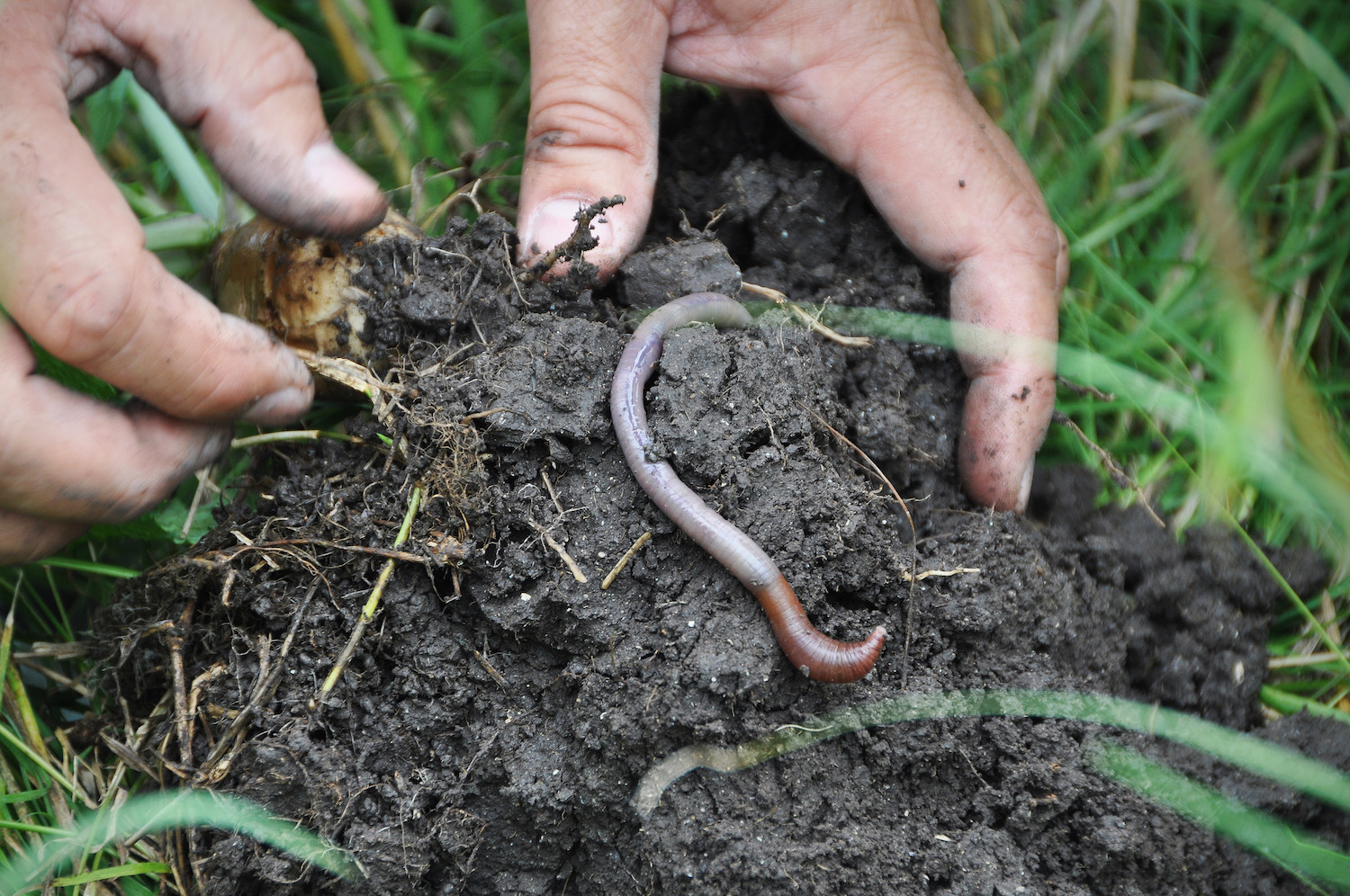New Food Economy: Regenerative agriculture could save soil, water, and the climate. Here’s how the U.S. government actively discourages it.
by Jessica McKenzie | March 14th, 2019
Cover crops and other regenerative agriculture practices are still pigeonholed as conservation practices, not as good farming practices. But if farmers want crop insurance, they have to play by the rules.
Last year, a few days before Christmas, Gail Fuller drove me out to the middle of a wind-whipped field just north of Emporia, Kansas. “This is really where it started for me,” he said as he climbed out of the truck, spade in hand. With a thunk, he drove the spade into the ground and pulled out a hunk of earth, holding it up so I could see the texture, which he described as like “chocolate cake” and “black cottage cheese.”
Pointing to a wriggling earthworm, a sign of good soil health, Fuller explained that conventional, tilled fields would be too cold for earthworms to be that close to the surface. Tilling rips up and compacts soil, compressing the air pockets that would otherwise insulate earthworms from temperature extremes. But because Fuller never tills and maintains a continuous living root system, which provides additional insulation, his field has earthworms year-round.
Fuller’s approach is part of the broader “regenerative agriculture” movement, a way of farming that prioritizes soil health and has a host of other benefits, from carbon sequestration to reducing nutrient runoff. In the mid-1990s, he stopped tilling his fields to improve water retention, increase soil nutrients, and help counter erosion. In 2002, he began planting cover crops, grains and legumes that cover land through the winter, and can help control weeds, increase biodiversity, and capture carbon. Fuller also drastically cut down on his use of herbicides, pesticides, and fertilizer.
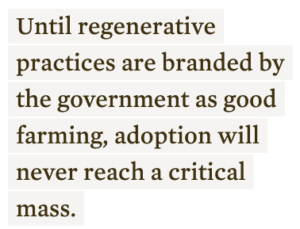 This long evolution has improved his farm’s health and profitability. But Fuller is one of many regenerative farmers who feels that government policies have actively worked against them.
This long evolution has improved his farm’s health and profitability. But Fuller is one of many regenerative farmers who feels that government policies have actively worked against them.
In 2012, a historic drought year, Fuller’s approach to farming cost him a crucial crop insurance payout: His insurance company denied his claim because days of harsh, dry winds prevented him from terminating his crops in line with the government’s strict timeline. He spent almost two years fighting for the money, and though he eventually won his case, he lost his operating line of credit at the bank while he waited—and subsequently lost much of his land.
The United States Department of Agriculture (USDA) has delivered perfunctory messages about the benefits of cover crops and other regenerative agricultural practices. But, for years, the agency has effectively discouraged farmers from planting cover crops through confusing and overly restrictive rules set by the Risk Management Agency (RMA), an agency under USDA that determines crop insurance eligibility, a lifeline for many farmers. Fuller and other producers have fought for those rules to be lifted, and the most recent farm bill finally does away with the worst and most restrictive rules. Now, as long as farmers make a good faith effort to terminate their crops according to USDA guidelines, they cannot be denied a payout if drought or floods or other acts of Mother Nature impede their work. However, until cover crops and other regenerative practices are branded by the government as good farming, instead of merely good environmental stewardship, adoption will never reach a critical mass.
In theory, the RMA is an independent government agency, a neutral arbiter of rules and regulations. But multiple sources told me on background that they believe the agency essentially publishes rules that the agribusiness industry supplies. And the industry doesn’t want cover crops. Crop insurance companies are reluctant to introduce variables they don’t understand and that might come with new risks; the broader agricultural industry has a vested interest in farmers needing to buy its pesticides, herbicides, and fertilizers in ever-increasing quantities. The use of cover crops threatens that demand.
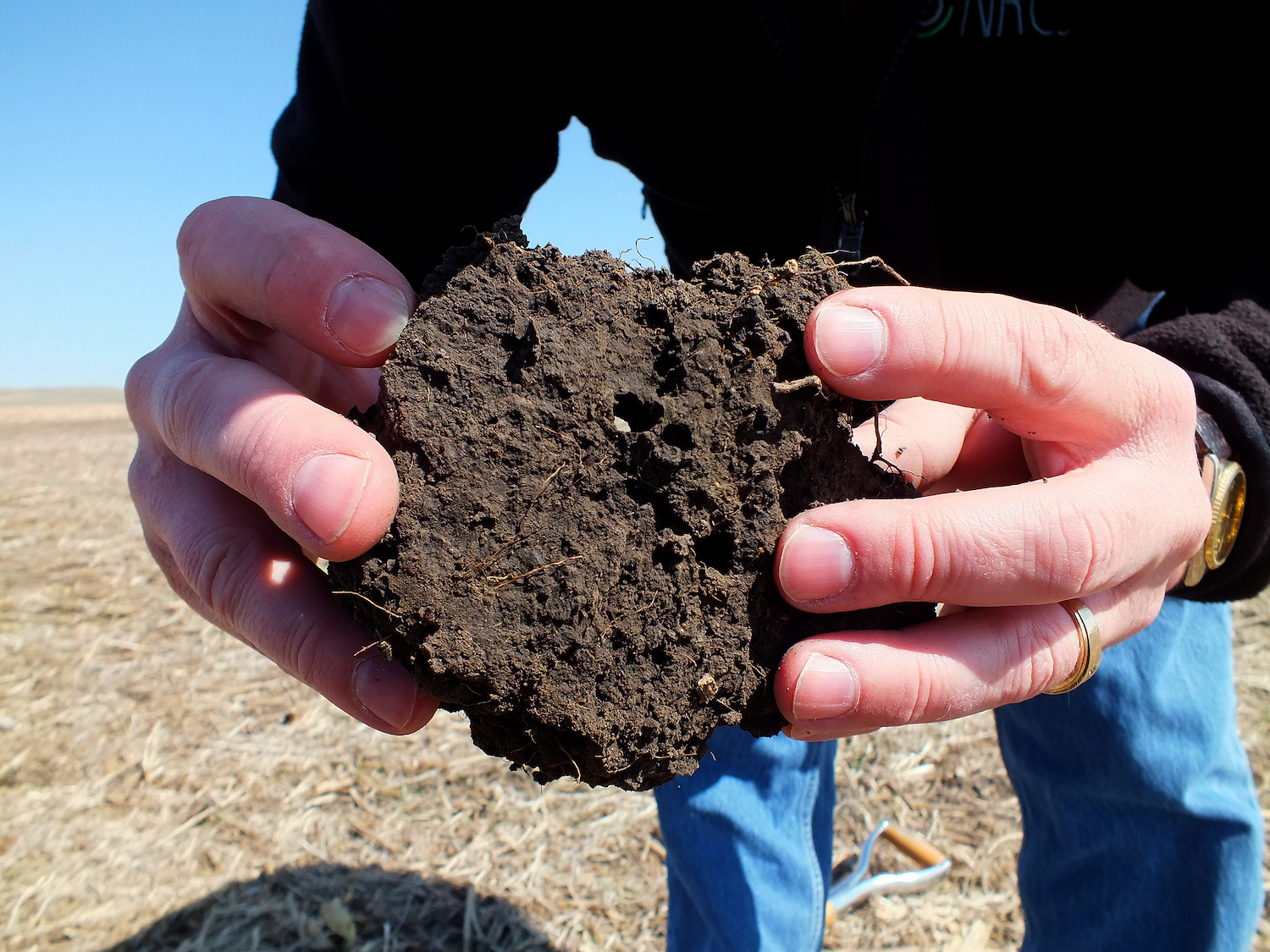
Natural Resources Conservation Service / Flickr
Healthy soil resembles “chocolate cake” and “black cottage cheese,” and contains air pockets that insulate earthworms from temperature extremes
The year Fuller’s insurance provider denied his claim, based on the RMA’s cover crop rules, the country-wide drought was so bad that a crop insurance industry group has dedicated a web page to it. Fuller began the long process of challenging the denial, but in the years that followed, landlords gave his acres to farmers who could afford to put seed in, and who wouldn’t rock the boat so much. Others sold off the land he had been farming and he didn’t have the money to buy it back. Fuller struggled to afford the seed and fertilizer for the acres he still had.
“The upside is they pushed us to this, which is where we really wanted to be anyway,” Fuller said. “So there’s really a lot of good to come out of it. We wouldn’t have had the courage to do this without being broke and not having an option.”
“This” means pivoting away from commodity crops and moving toward a more diversified approach to agriculture: a system where grass-fed cows, sheep, heirloom pig breeds, and chickens rove a more biodiverse landscape. Many of Fuller’s fields are planted with perennial plants and native grasses that he has let go to seed, which the ruminants graze on a rotational basis. Fuller went from farming 3,200 acres of corn and soybeans in 2000, to just 400 acres in 2018, very few of them planted with commodity grains. And this way, for reasons I’ll explain, he doesn’t need crop insurance in the first place.
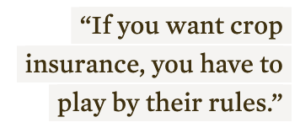 Farmers have been experimenting with different regenerative agricultural practices since the late 1980s, although they might not have used that term back then. Steve Swaffar, executive director of No-Till on the Plains, said that soil erosion was a major factor. Even though farmers were following standard best practices, topsoil was still running off their fields. They began looking for solutions. A few people pulled together a conference on alternative farming methods in 1995, and soon the Kansas Crop Residue Management Alliance was established as a nonprofit. The organization was later renamed No-Till on the Plains, a catchier rebrand that still belies the broad scope of its mission, which is a systems-based approach to agriculture that includes no-till, cover crops, crop rotation, and livestock integration.
Farmers have been experimenting with different regenerative agricultural practices since the late 1980s, although they might not have used that term back then. Steve Swaffar, executive director of No-Till on the Plains, said that soil erosion was a major factor. Even though farmers were following standard best practices, topsoil was still running off their fields. They began looking for solutions. A few people pulled together a conference on alternative farming methods in 1995, and soon the Kansas Crop Residue Management Alliance was established as a nonprofit. The organization was later renamed No-Till on the Plains, a catchier rebrand that still belies the broad scope of its mission, which is a systems-based approach to agriculture that includes no-till, cover crops, crop rotation, and livestock integration.
“When you put it all together, that’s when you get a complete farming approach that I think is certainly superior from an environmental standpoint,” said Swaffar. “And we’re seeing more and more evidence that it’s superior from an economic standpoint.”
Darin Williams, a Kansas farmer who grows a mix of corn, soybeans, and cereal crops on 2,000 acres, and incorporates practices like no-till and cover crops, says his input costs are significantly lower than his peers. He needs less fertilizer and half as much herbicide; when herbicides can cost anywhere between $20 to $40 per acre, the savings add up quick.
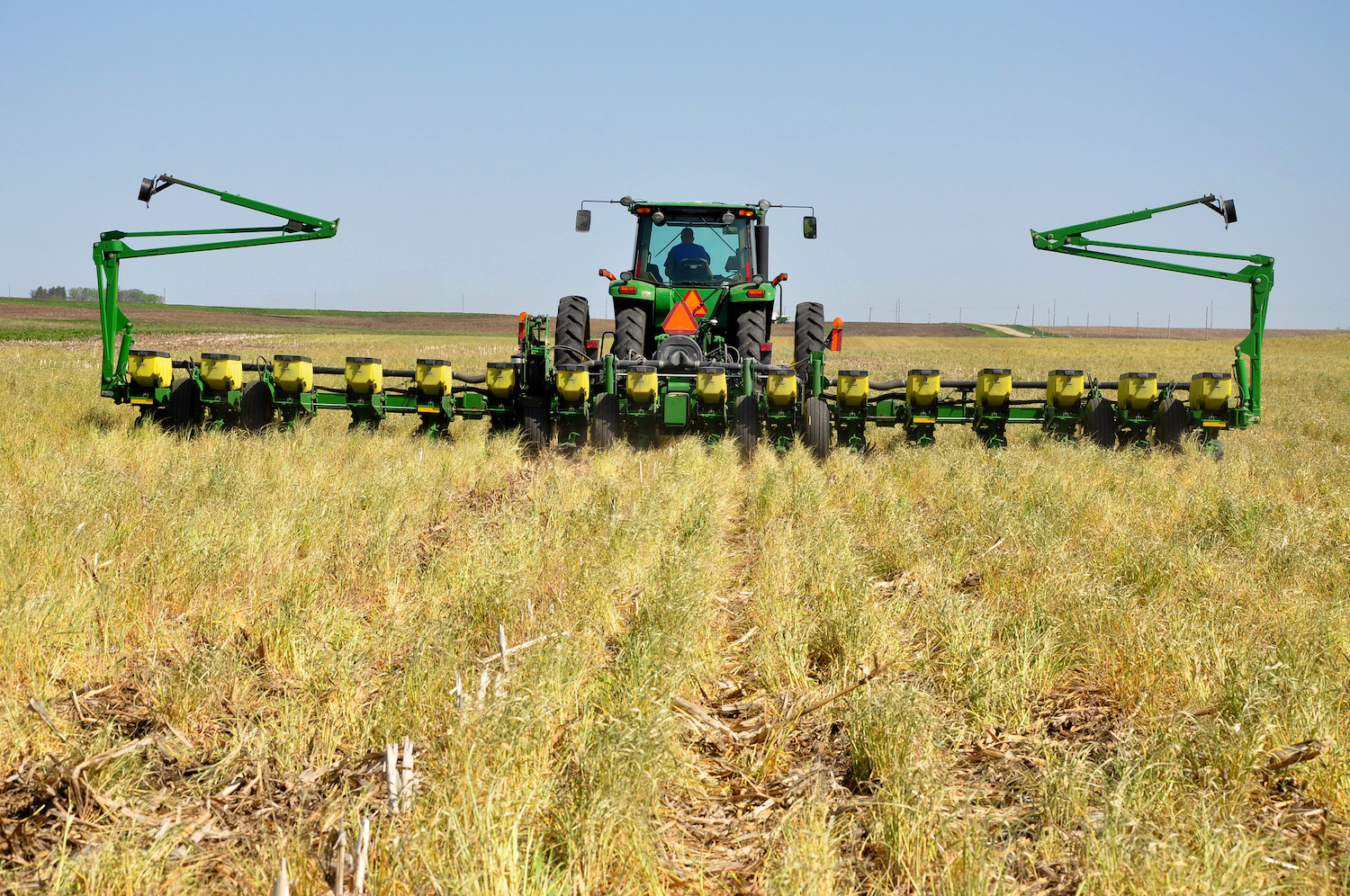
Natural Resources Conservation Service / Flickr
A no-till planter plants soybeans into a terminated cereal rye cover crop in Iowa
Even as evidence of the benefits of cover crops mounted, the government held onto rules that discouraged their use. Although crop insurance is administered by private companies, the federal government manages and subsidizes the industry, and sets the rules that determine crop insurance eligibility. Most of those rules allow farmers to farm the way they see fit, as long as that is within a fairly broad range of good farming practices; fertilizer, pesticide, and herbicide use are all left to farmer discretion. But for years, the RMA dictated how farmers could use cover crops by setting strict termination dates—dates that may not make sense in a particular location or in a given year.
“If you want crop insurance, you have to play by their rules,” Swaffar said. “Many of the farmers that come to our events would tell you, ‘If I didn’t have to follow those rules, I could be a lot more productive and a lot more effective as a farmer,’ but because crop prices only offer very slim profit margins for producers, they’re almost financially obligated to carry crop insurance.”
For example: Last spring was unusually cold in Iowa. Sarah Carlson, the director of Strategic Initiatives for Practical Farmers of Iowa, said that when it came time to plant soybeans, cover crops across the state were barely two inches high. “Agronomically, they should have planted soybeans as early as possible and let the cover crop grow until it reached about knee-height to get weed control benefits from it,” Carlson said. But that would have been “off label” and against RMA policy. Practical Farmers won a deviation for two farmers that allowed them to go off book without jeopardizing their crop insurance. All that effort, Carlson said, was “a waste of time.”
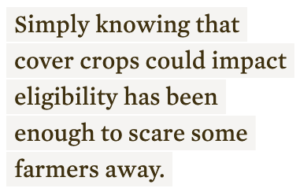 “Farmers should be allowed to farm the way they feel is best,” Carlson said. “RMA should get out of the agronomy business.”
“Farmers should be allowed to farm the way they feel is best,” Carlson said. “RMA should get out of the agronomy business.”
In addition to making it overly onerous for farmers to implement cover crops in a way that works for them, RMA policies have had the effect of scaring off farmers who might otherwise be interested in cover crops.
Approximately 90 percent of the insurable farm acreage in the U.S. is protected by crop insurance. Many farmers have to have it in order to qualify for operating loans from the bank. Simply knowing that cover crops could impact eligibility has been enough to scare some farmers away.
After Fuller was denied his crop insurance payout, he said farmers would come up to him during events that he attended or spoke at, and say, “I’m not gonna do cover crops now,” or “I was doing cover crops and I quit, because I can’t afford to lose my insurance.”
“So it did set the movement back, for a few years,” Fuller said.
While financial concerns can keep farmers from experimenting with cover crops and other regenerative practices, some farmers try them when they fall on hard times, as a last resort.
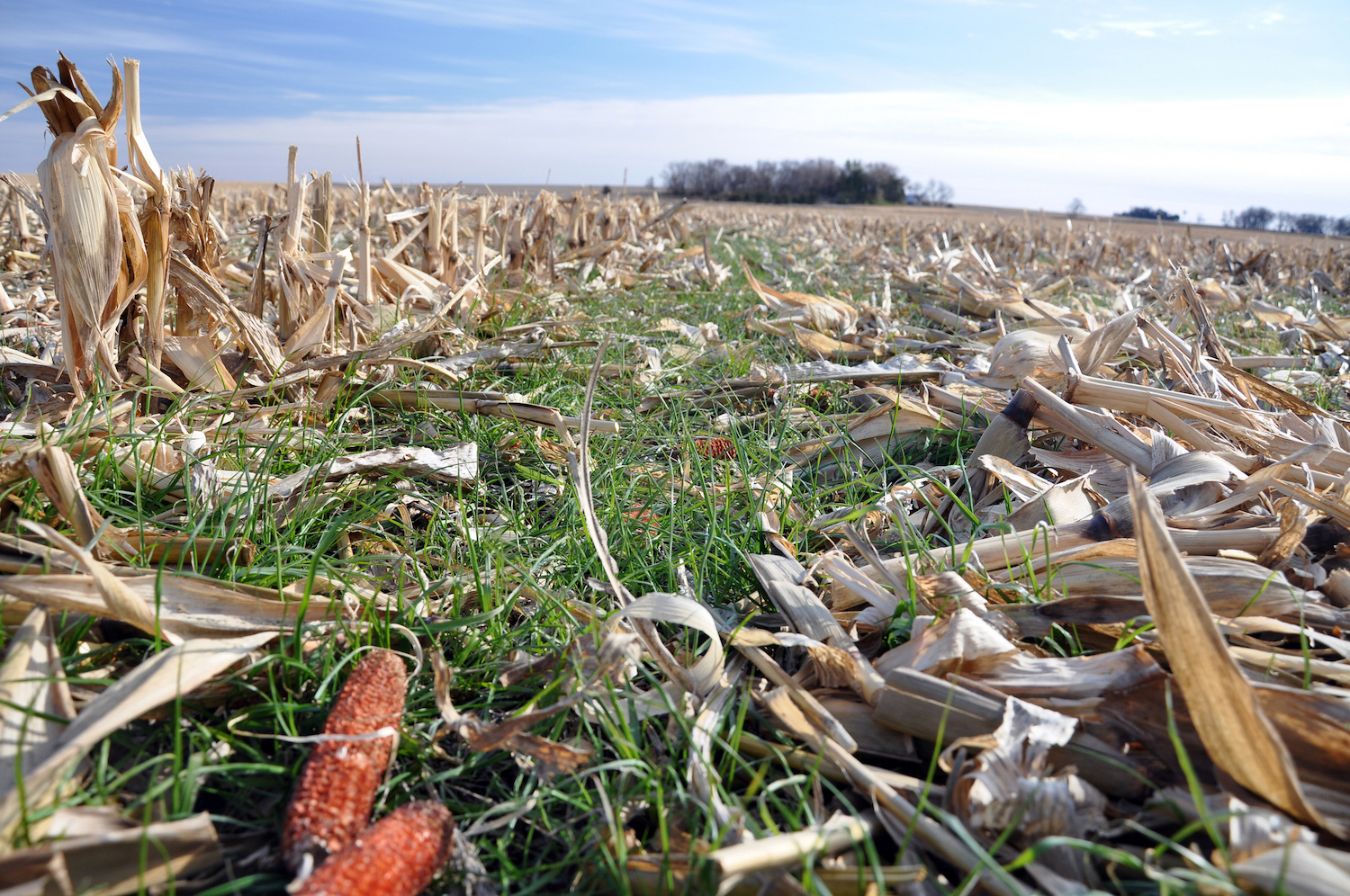
Natural Resources Conservation Service / Flickr
Even as evidence of the benefits of cover crops mounted, the government held onto rules that discouraged their use
“I don’t think you find many who actively said, ‘I just want to do this for the benefit of the climate or the environment,’” said Mike Lavender, who works on food and environmental issues for the Union of Concerned Scientists. “You typically find that people, for whatever circumstance, were forced into and have found a way to make it work.”
Many of the farmers practicing regenerative agriculture, including cover crops, have begun to self-insure; it’s not ideal, but the way the crop insurance industry works leaves them little choice. What they have found is that cover crops and other regenerative practices have made them less susceptible to yield variations from year to year.
Ryan Stockwell is the director of sustainable agriculture at the National Wildlife Federation and helped Fuller win his crop insurance claim; he also farms 110 acres in Wisconsin, and forgoes crop insurance entirely.
“As a farmer, I’ve been doing no-till, cover crops, and a diverse crop rotation for eight years now, and I’m getting to the point where I’m not seeing any major yield variation that my neighbors are experiencing,” Stockwell said. “So why should I pay $15 an acre for no return?”
Right now, crop insurance is based entirely on the county in which you live. The RMA calculates risk that way because weather across a single county is fairly consistent, and weather is a huge factor in farm yields from one year to the next. The comparison I heard over and over again was that it’s like giving everyone who lives in the same neighborhood the same car insurance rate, without a “good driver” discount.
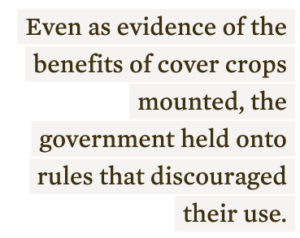 Stockwell and others want the crop insurance industry to be restructured in order to take practices that decrease yield variability—and therefore lessen risk for the insurance company—into account. They want a “good farmer” discount for farmers who use practices that stabilize yields, but that also have broader environmental benefits. By that logic, regenerative farmers should be cheaper to insure.
Stockwell and others want the crop insurance industry to be restructured in order to take practices that decrease yield variability—and therefore lessen risk for the insurance company—into account. They want a “good farmer” discount for farmers who use practices that stabilize yields, but that also have broader environmental benefits. By that logic, regenerative farmers should be cheaper to insure.
“Instead of having a county average that defines your risk, regardless of practices that you use in that county, instead we may see a larger geographic pool that they put people in, but there would be a number of different pools within that geography,” said Stockwell. “So, it could be a four, six, or eight county area, and they pool the farmers who have a two-crop rotation, or they pool the farmers who have a three-crop rotation plus cover crops plus no-till.”
One possible reason that policy hasn’t gained momentum? Cover crops and other regenerative agriculture practices are still pigeonholed as conservation practices, not as good farming practices.
“NRCS [National Resources Conservation Service] and the federal government have been a big proponent of cover crops over the last 10 years, and that’s really good,” Carlson said. “They’ve changed from only promoting practices that deal with erosion, like terraces, to practices that improve soil and water all the time, like cover crops, and that’s great. But then it’s branded cover crops as just an improvement to soil and water, and not an improvement to corn and soybeans.”
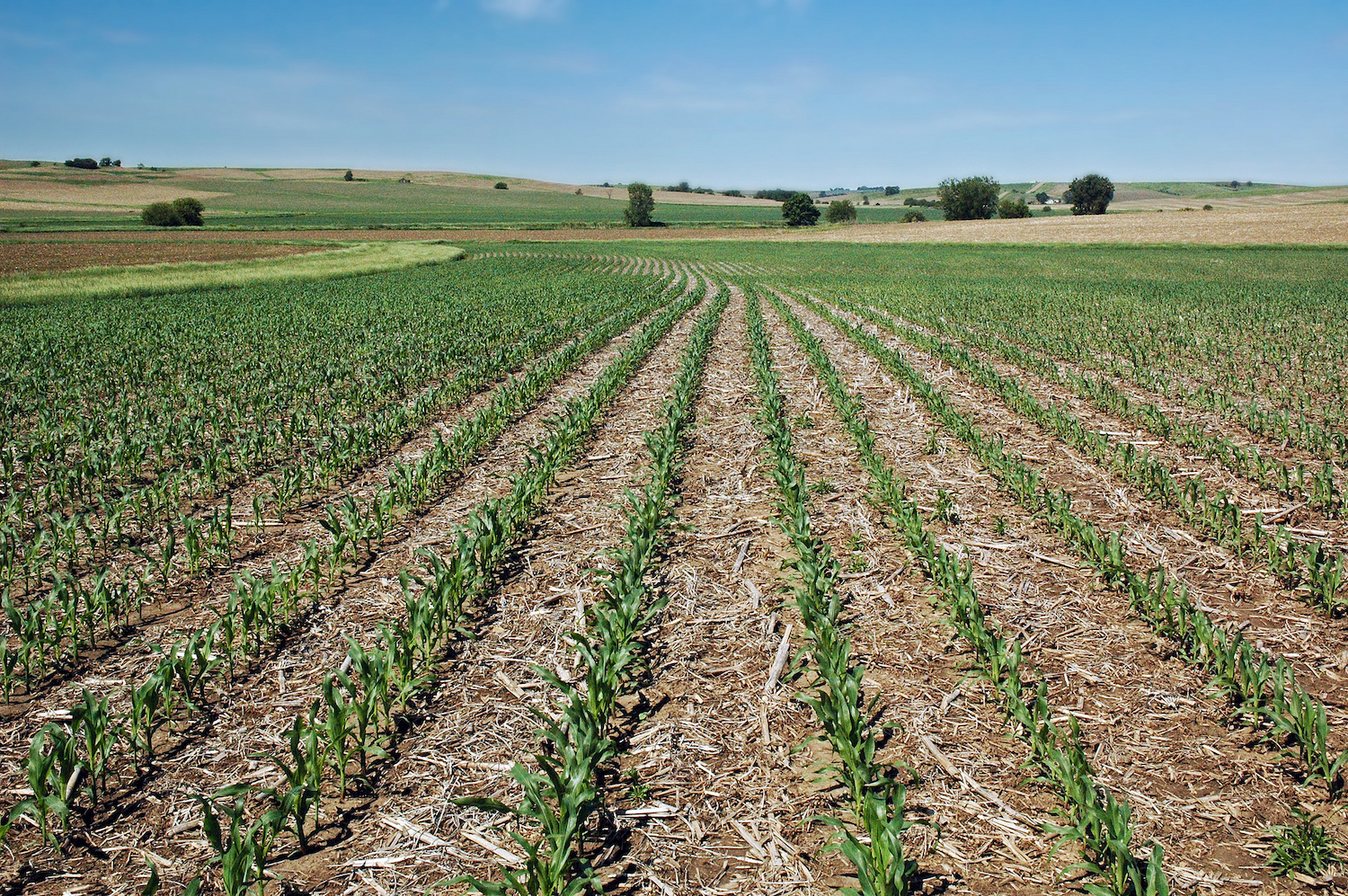
Natural Resources Conservation Service / Flickr
Corn crops grow through soybean stubble on a no-till farm
So, while that messaging has persuaded the few farmers willing to prioritize the environment for altruistic reasons, it has also left a lot of farmers behind. In Iowa, for example, Carlson said there were approximately 800,000 acres that were planted with cover crops last year. “Which sounds like a big number,” she added, “but to affect water quality in this state, we need 12 to 16 million acres.” In 2017, Carlson told The New Food Economy that 50,000 of Iowa’s 88,000 farmers would need to plant cover crops to significantly improve the state’s nitrate-saturated water.
The federal government does encourage cover crops through programs like the Environmental Quality Incentives Program (EQIP) and the Conservation Stewardship Program (CSP), which both compensate farmers for planting cover crops. But there are rules and eligibility restrictions (some programs only accept first-timers) that keep these from spurring widespread adoption. Darin Williams said that he knows farmers who will cynically accept contracts from those programs just to get the payout, and then stop using cover crops as soon as they are no longer eligible.
 There is also more interest in the programs than there is cash to go around. In 2017, they were characterized by a National Resources Conservation Service staff member as “underfunded and oversubscribed.” While some conservatives pushed to consolidate the programs into one under EQIP’s banner and eliminate some of CSP’s projects, both programs made it into the most recent farm bill intact. However, the already budget-strapped conservation programs will see significant funding cuts over the next decade, which means fewer farmers will be able to benefit, and the impacts on soil and water quality will be correspondingly diminished.
There is also more interest in the programs than there is cash to go around. In 2017, they were characterized by a National Resources Conservation Service staff member as “underfunded and oversubscribed.” While some conservatives pushed to consolidate the programs into one under EQIP’s banner and eliminate some of CSP’s projects, both programs made it into the most recent farm bill intact. However, the already budget-strapped conservation programs will see significant funding cuts over the next decade, which means fewer farmers will be able to benefit, and the impacts on soil and water quality will be correspondingly diminished.
One state that has largely figured it out is Maryland. For the past five years, more than 50 percent of the available acres for cover crops have been planted with them, according to Hans Schmidt, the assistant secretary for the Maryland Department of Agriculture. The secret to their success? First, there is a cost-share program that anyone can participate in, whether they are first-timers or have been planting cover crops for decades. Then, there’s also a tax base and state leadership willing to fund the program—broader public recognition that it’s one of the most cost-effective ways of reducing nutrient runoff to the Chesapeake Bay.
Such a windfall from the federal government is unlikely, to say the least. But unless crop insurance is restructured to benefit farmers doing things that are good for the farmland, good for the environment, and good for their yields, the federal government is going to continue subsidizing the degradation of American soil.
